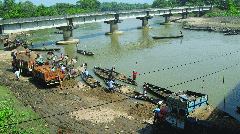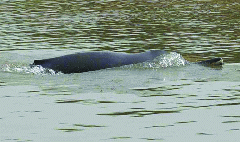Archives
The Survival of a River
This is perhaps why Tapas Das (53), a former sand miner and presently owner of five boats has reason to say, “Our forefathers used to tell us that there are gold and diamonds hiding inside the river. We did not realize what they were saying. But today, I can really understand that this river has given us a lot, much more than what we expected. We are now earning much more because of the river.”
A fisherman by birth till he left his profession, Das is a resident of No. 3 Amtola village in the Kukurmara area. The river flows through his ancestral village. He had to shift from traditional fishing due to economic hardship and had to work out an alternative living that ensured him square meals a day, that was way back. Today, he considers himself fortunate that the river is always with him during his penury and comfort. A life without the river is just beyond his belief.
Das engages five workers for his country-boats used for sand mining. Each boat fetches him Rs.30 on every trip as he has to give the workers Rs. 120a day. He has purchased some agricultural land from the money he earned from sand mining, where he cultivates rice and vegetables.
The river that originates in Meghalaya carries a huge amount of high quality sand from the hills of Meghalaya on its course each  year particularly during the monsoons. Regular sand mining by locals indeed has a positive impact in the maintenance of the river-bed, which has in turn a pluralistic role in freeing the region from erosion as well as supporting an ideal habitat for the river dolphins.
year particularly during the monsoons. Regular sand mining by locals indeed has a positive impact in the maintenance of the river-bed, which has in turn a pluralistic role in freeing the region from erosion as well as supporting an ideal habitat for the river dolphins.
Sand mining activities started on the river nearly 35 years ago. Initially it was on a very small scale with a few country boats. With the rapid expansion of Guwahati and other urban pockets of Assam and a boom in construction activities, the demand has been increasing day by day. As the quality of the sand of the river is very high, the demand has been increasing significantly, say the workers.
There are six sand-mahals covering two development blocks of the district - three in Rampur block, and three in Chaygaon block. Chandan Bora, who is one of the Mahaldars (bidder) is Amtola sand-mahal, says that about 1000 country boats are engaged in sand mining activities in Rampur block. Over 5,000 families of the block are solely dependent on the sand mining industry, according to his estimate. An equal number of families are engaged in the nearby Chaygaon block, which is just 6 km away from Kukurmara point.
Bora claims that the earning of the workers engaged in sand mining is reasonable. “It takes one worker up to five hours to mine one full-load of sand for a country-boat. Although extraction of sand for one fully-loaded boat normally takes an hour, the worker has to take his boat to distant areas in search of quality sand. If the worker owns a boat, he can earn Rs.150 per trip, which is the rate for sand per boat. Otherwise, he gets Rs120/ and the rest is taken by the owner of the boat. Sometimes they mine twice a day and the earning becomes double. This is a fair income considering the physical labour involved in the work,” Bora says.
 During the monsoons when the river swells up with rainwater gushing in from the Meghalaya hills, workers are required to take their boats several kilometers upstream in search of a relatively shallow location, which is a tough job. During winter they have to move in the opposite direction. This has compelled people to start for work early in the morning, or even late in the night chasing the moonlight, when it is present, to minimize physical labour.
During the monsoons when the river swells up with rainwater gushing in from the Meghalaya hills, workers are required to take their boats several kilometers upstream in search of a relatively shallow location, which is a tough job. During winter they have to move in the opposite direction. This has compelled people to start for work early in the morning, or even late in the night chasing the moonlight, when it is present, to minimize physical labour.
Sand thus loaded in country-boats is brought downstream and deposited on the bank of the river in the Rampur block. A different batch of workers then loads the sand onto trucks. Every day about 200 trucks carry the sand to different destinations for unloading at the construction sites. The sizes of trucks may vary, but on an average, every truck-load of sand costs about Rs.3,000. This means that the average transaction of the sand-industry in Rampur block is Rs.6,00,000 a day, provided, the trucks make a single trip a day. Sometimes, these trucks make more than one trip.
“It is a people’s industry and that is why it has been sustained over the years. Our local people are not greedy. They are happy with their small but steady earnings. I think that this is one of the reasons for the huge success of the industry. Again, unlike many other such businesses there is no interference of middlemen or outsiders. The entire industry is run by local people. Some of the mahaldars of today once used to be owners of boats. Some even have the experience of working as sand miners,” says Bubul Bora, a villager of Jiyakur Na-vitha, a former sand miner and presently owner of 12 boats, who has an association of three decades with the sand mining activities at the river.
Apart from the sand-miners who are the grassroots workers directly associated with the industry, a sizeable section of the people are engaged in the loading of sand in trucks and unloading at designated places. An allied industry for the repairing of country-boats is also booming in the locality thus giving livelihood opportunities to a number of families.
As regular extraction of sand from the river has helped in maintaining the depth of the river-bed, the locality sometimes faces the problem of annual flood due to the backwater of the river Brahmaputra, which Kulsi meets some kilometers ahead, however, it is not an erosion-prone river.
Apart from providing livelihood opportunities, the important aspect of the industry that involves a money-transaction of several lakhs each day is its eco-friendly nature, and its capability in adapting to climate change. Significantly, the river-bank people involved in the business have made it possible that such a commercially viable and sustainable industry can be built up, practically without using a single piece of machinery! They only use their country boats, buckets to collect sand, and spades for loading and unloading, thus the quality of the river water remains fresh and filtered every moment.
While the males, particularly from the fishing community have found alternative sources of livelihood in the river through sand mining, women folk have taken to the spinning of raw silk to help their family income. This too has minimized the over dependence of the people on the river for fishing.
These alternative livelihood opportunities have resulted in another wonder. Less dependence on the river by way of fishing ensures a staple diet for the Xihus. Additionally, a well-maintained river-bed and the eco-friendly nature of the industry have guaranteed an ideal habitat for these unique aquatic animals. A scientific study on river dolphins conducted by Aaranyak, a society for biodiversity conservation in North East India conducted in 2008 also revealed an increase of the Xihu population in river Kulsi - from 27 in 2005 to 29 in 2008. These aquatic animals in Assam are found in the main course of the river Brahmaputra and two of its tributaries—Kulsi and Subansiri. Significantly, the study has revealed that although the population has increased in Kulsi, there was a decreasing trend in Subansiri, another tributary of the Brahmaputra, from 26 in 2005 to 23 in 2008. The survey recorded 264 river dolphins in the state, an increase in the population of 250 recorded by the 2005 survey.
In the river Kulsi, which is a tourist attraction because of the river dolphins, it is awesome to witness these Xihus moving with rows of the country-boats of the sand miners on bright mornings while they are busy at work. The Xihus also love to play around the boats as they know these boatmen never harm them. The sand miners know the exact location of the Xihus and this helps them to earn some extra money by acting as guides to the tourists.
While local people are deriving optimum benefits from the river without polluting its water, geological and hydrological experts in Guwahati are busy exploring possibilities of utlising the fresh and naturally filtered water of the Kulsi in their search for solutions to the acute shortage of drinking water in Guwahati.
Bipul Khataniar, a geologist in Guwahati says that the proximity of the river to the capital city has presented the possibility of utilizing this water to address the problem of acute shortage of safe drinking water. “The water of Kulsi is pure and naturally filtered, which will minimize the cost of water purification if an ambitious project of drinking water supply can be chalked out by the administration,” he says.
While viewing these opportunities Chandan Bora, however, raises a word of caution against over extraction of sand from the river.
“As the population has increased and there is no other means of livelihood in the area, local people readily opt for sand mining activities. This has led to over extraction of the river-bed, which may have an adverse impact on the river”, he adds.
Ratna Talukdar

